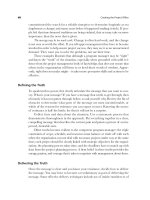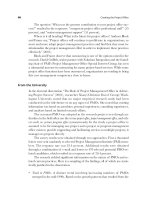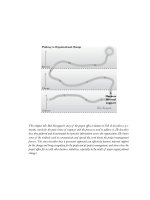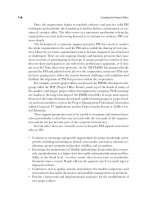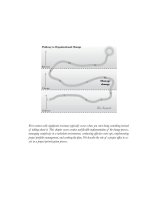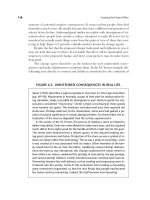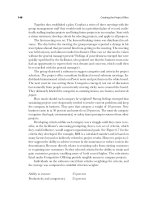Creating the project office 17
Bạn đang xem bản rút gọn của tài liệu. Xem và tải ngay bản đầy đủ của tài liệu tại đây (78.1 KB, 10 trang )
unaware of, potential negative consequences. It turns out that people often find
themselves much worse off, usually because they have a different interpretation of
what is better for them. Anthropological studies are replete with descriptions of sit-
uations where people from outside a culture attempted to make life better for its
members but actually made things worse from the point of view of those they were
trying to help. Figure 6.2 provides valuable modern lessons for change agents.
Despite the fact that the proposed change looks good and righteous to you, it
may not look that way to others. It is possible that there will be unintended con-
sequences to the proposed change, and these consequences may do more harm
than good.
The change agent should be on the lookout for such unintended conse-
quences and make adjustments to minimize them. In the Yir Yoront example, dis-
tributing axes directly to women and children contributed to the confusion of
138 Creating the Project Office
FIGURE 6.2. UNINTENDED CONSEQUENCES IN REAL LIFE.
Spicer (1952) describes a typical example in Steel Axes for Stone Age Australians
(pp. 69–90). Missionaries in Australia, as part of their plan for raising native liv-
ing standards, made it possible for aboriginals to earn Western goods the mis-
sionaries considered “improving.” Under certain circumstances these goods
were handed out gratis. The handouts included steel axes that replaced old
stone axes. Perhaps unknown to the missionaries, stone axes had gained a po-
sition of cultural significance in certain aboriginal tribes. For these tribes, the in-
troduction of the steel ax degraded their life as they experienced it.
In the society of the Yir Yoront, the process of making a stone ax helped to
define masculinity. Only men were allowed to make stone axes, and this required
much skill to find a right wood for the handle and find a right tree for the gum.
The stones were obtained from a distant quarry so this required trading dur-
ing great ceremonies and fiestas. Production of the stone ax was a symbol of re-
liance on nature rather than technology. The ax was a pride of ownership—once
it was created as it was associated with its creator. Other members of the fam-
ily would borrow the ax from the father, solidifying various kinship relations.
Once the steel ax was introduced, this change weakened the values inherit in
their reliance on nature, weakened the prestige of masculinity, the age prestige,
and various kinship relations. Family members became confused and insecure.
Ownership became less well defined, so that stealing and trespassing were in-
troduced into the society. Some of the excitement from trading surrounding
great ceremonies evaporated, so that the only fiestas that people had became
less festive and less interesting. Indeed, life itself became less interesting.
ownership, which was then partially responsible for the introduction of stealing
and trespassing. Perhaps if the axes had been distributed only to the men, then
ownership would have remained clear, and stealing might not have arisen. Of
course, this is speculation and a change in distribution might have had no effect.
In addition, there was little incentive for missionaries to change their ways
because the indigenous tribes were not in positions of power. But in organizational
situations the people affected by the change program often are in positions of
power and thus their points of view need to be taken into consideration.
The change agent should be particularly sensitive to other people’s points of
view when beginning to implement changes. Investigate or speculate about what
unintended consequences may occur or simulate or prototype what might hap-
pen in the organization when a project office takes on increasing responsibilities
in new territories.
Sustaining Balance
Managing change requires a balancing act. Project management deals with the
triple constraints of scope, schedule, and resources, but it has another triangle to
consider as well (see Figure 6.3). Management charters projects to achieve a level
of performance, getting results. But what is the experience of team members on those
projects—what do they encounter as they work to create those results? Is it stress,
burnout, and fatigue that leave them thinking, “never again”? Or is it energizing,
fun, rewarding, productive? Do people at the end of projects rapidly disappear or
do they say, “Call on me next time you’re doing a project—I really enjoy working
with you”? If the experience is not good, over time project performance goes
down. What type of learning takes place, both during and at the end of the project?
Contact 139
FIGURE 6.3. THE WORK TRIANGLE.
Learning
Performance Experience
If people (and organizations) do not learn from mistakes or get reinforcement for
what they did well, performance over time goes down.
Informal surveys among workshop participants typically reveal that most at-
tention is focused on results. Very few program objectives include “have fun” and
“get better at doing projects.” When they do, however, you find an energizing at-
mosphere where amazing and wonderful things happen.
Timothy Gallwey says, “The three sides of the work triangle are part of an
interdependent system. When either the learning or the enjoyment side is ignored,
performance will suffer in the long run. When it does, management feels threat-
ened and pushes even harder for performance. Learning and enjoyment dimin-
ish even further. A cycle ensues that prevents performance from ever reaching its
potential” (2000, pp. 86–87). He adds, “When a few individuals make the com-
mitment to their own learning and enjoyment, they serve as catalysts for others
by the qualities they express while doing their work. Those who accept such a
challenge may accomplish much more as a result of their work than the perfor-
mance results they are compensated for” (p. 106).
To implement a project office for organizational change, strike a dynamic but
balanced relationship among these three factors. The project office is in an ideal
location to do this.
Sustaining balance requires great care when working among a variety of situa-
tions. Managing change to a project environment involves a similar quest to the story
in Figure 6.4—and sometimes the same outcome. All too often, in working with good
people and the best of intentions, we engage in too many projects with unclear ob-
jectives, fighting for resources, and the politics get ugly. To create a different scenario—
the good, the true and the beautiful—the three factors we need to balance are professional
project managers, upper management, and the enterprise project management
process. All three viewpoints need to be balanced and integrated. Good people are es-
sential to make the project office successful. Upper managers need to act with au-
thenticity and integrity. Processes are the methods and tools to get the job done.
140 Creating the Project Office
FIGURE 6.4. WORKING TOGETHER: THE PESSIMIST’S VIEW.
The movie The Good, the Bad and the Ugly is about another triad: Blondie (the
Good) learns the name of the grave under which the gold is buried, Angel
(the Bad) rounds up everyone in search of the gold, and Tuco (the Ugly) knows
the name of the cemetery where the gold is buried. It’s a quest for money: man
against man against man, and may the fastest draw win. No one person knows
the whole picture and they depend on each other. In the final gunfight, tension
mounts higher and higher until it erupts in a blaze of gunfire.
Be guided by an inner knowing that the practices and processes employed, in
the hands of master program managers and teams, are proven tools to craft out-
standing results. All three categories or players are necessary before you have a
decent story to tell. Help people sense the excitement that comes from creating
something wonderful together.
Several cautions are in order, however. Watch out for these potential sources
of sabotage:
• Staffing the office with the wrong people, both in abilities and attitude, can be
disastrous.
• Upper managers who go through the motions of support for the sake of ac-
tion provide only an illusion of productivity. People in the organization sense
the lack of authenticity and integrity and do not put heartfelt effort into the
process.
• Most managers say they want results, but careful observation of actions often
indicates they are more interested in control. Control is usually an illusion, so
focus effort on results, not on controls.
• Software tools are not project management. Implement common tools and
procedures, but only after the process resides in the heads, hearts, and souls of
participants.
• If organizations do not clarify and prioritize strategic goals, individuals decide
on their own. Then you get whatever people want to do, not necessarily what
is strategically important. The de facto strategy for the organization becomes
the sum of uncoordinated individual actions.
Noted systems thinker Peter Senge (1999) offers another caution related to
purpose and direction of the organization, “Conversations about power struc-
tures or control, without including consideration of where the organization needs
to go, are counterproductive. They lead to organizations where control itself be-
comes part of the organization’s purpose” (p. 367). He also goes on to suggest that
people with internal networking capabilities are the ones who make change hap-
pen, “Ironically, those with the least formal organizational authority may hold
many of the keys to better understanding the leadership communities that will
determine organizational vitality in the future” (p. 568).
Project Portfolio Management
Managing or overseeing a portfolio of projects to achieve strategic goals is start-
ing to come under the purview of a project office. It is one of the last areas to be
developed or usually occurs at higher levels in a project management maturity
Contact 141
model. Investing in a project office to implement this process offers perhaps the
highest potential for significant return to the organization. Its political nature also
makes it one of the most difficult areas to implement.
Robert Cooper (1998) describes the way many organizations flow projects
through a tunnel: all projects or product ideas begin (go in), are in the dark most
of the time, and all attempt to go to market (come out), most resulting in failure.
A preferred model is to funnel good ideas into the critical few projects and focus
on making them successful—funnels not tunnels. The linkage to strategy via a dis-
ciplined process can make this happen. A project office is the means to apply the
discipline.
EXFO, an electro-optical engineering company in Canada, uses the concept
of “funnel-to-tunnel” process to meet system objectives. Early product decision
checkpoints focus on strategic fit and the business case. The middle checkpoint
evaluates the technology fit and the ability to execute the project. From this point,
projects are expected to go all the way through even though there are more check-
points. The PMO coordinates the process and provides data.
The advantages are products that meet market requirements, better control
of project time-to-market, and increased return on investment (ROI). Since its
founding in 1985, EXFO has achieved 50 percent annual growth and employs
over a thousand employees. About 20 percent of those people work in R&D. Prod-
uct development process principles include concurrent engineering, product evo-
lution through complete operational iterations, and built-in flexibility to adapt
phases to each project.
Embarking on a strategic process for linking projects to strategy is a bit like
the song “Three Coins in a Fountain”—everyone wants to make sure their
projects survive the funneling process.
A vicious loop ensues (Figure 6.5) if there is no time to create a clear and widely
understood business vision: with no consistent prioritization of work, the vast di-
versity of activity leaves even less time to prioritize; then choices are made in iso-
lation, which creates duplication of effort or gaps in the product line; business
results are unsatisfactory and that brings us full circle around the loop to the lack
of a clear business vision.
Managers better serve their organizations when they focus attention on areas
that can make the greatest impact. Focusing on individuals affects only 1 to 2 per-
cent; doing training covers only 10 to 15 percent. Research shows that greater im-
pact is achieved when 80 to 85 percent of managerial effort is focused on the
environment—setting expectations and standards, providing more feedback, point-
ing out consequences, job engineering, and strategic alignment.
Steven Wheelwright also made the point for a PDMA International Confer-
ence audience that greater impact is possible when upper managers invest more
142 Creating the Project Office
